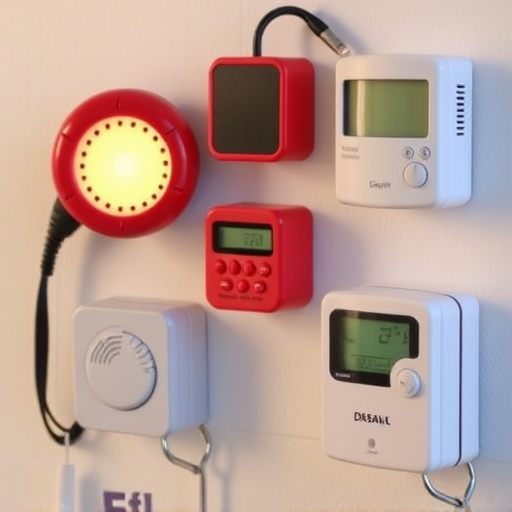Lone workers in remote areas face elevated risks from accidents to violence, making robust personal alarm systems essential. The best personal alarm sound distance should be 600-2000 feet, emitting over 100 dB to cut through noise and alert nearby people or emergency services swiftly. Advanced features like GPS tracking and automatic fall detection enhance safety response times. Choosing an alarm with a powerful sound, water resistance, long battery life, and easy design is crucial for lone worker safety, with training and regular drills reinforcing these measures.
In today’s digital era, many workers operate alone, posing unique safety challenges. This article explores comprehensive solutions for lone worker safety through alert systems, focusing on personal alarm devices. We delve into understanding the risks associated with isolated work environments and how effective personal alarms can mitigate these dangers. Key aspects covered include selecting the best personal alarm sound and distance standards, implementation strategies, and training to ensure optimal safety outcomes.
- Understanding the Risks of Lone Working
- The Role of Personal Alarm Systems
- Factors to Consider When Choosing a Personal Alarm
- Effective Personal Alarm Sound and Distance Standards
- Implementation and Training for Optimal Safety
Understanding the Risks of Lone Working
Lone workers, by definition, operate without immediate supervision or backup, which significantly increases their exposure to various risks. These can range from workplace hazards like slipping and falling, to more severe dangers such as violent encounters or medical emergencies. Understanding these risks is paramount in implementing effective safety measures. One critical component of preparedness is the use of personal alarm systems, especially when working in remote areas where help may be delayed.
Choosing the best personal alarm system involves considering factors like sound intensity—a loud, distinct signal increases the chances of being heard—and distance at which it can be heard effectively. This ensures that even if a worker encounters trouble, their alarm can alert nearby colleagues, emergency services, or the public, potentially saving precious time and preventing adverse outcomes.
The Role of Personal Alarm Systems
Personal alarm systems play a pivotal role in ensuring the safety and well-being of lone workers, offering a crucial line of defense in remote or isolated environments. These compact devices are designed to be easily portable and accessible, allowing users to quickly activate them when facing an emergency. One of the key features that set personal alarms apart is their ability to emit powerful sounds, with some models featuring best-in-class personal alarm sound distances reaching up to 100 decibels or more. This high decibel level acts as a strong deterrent against potential threats and can attract attention from nearby bystanders or emergency services.
When choosing a personal alarm, the distance at which the sound travels is an essential consideration. The best personal alarm sound distance varies depending on the environment—for instance, in urban areas with background noise, a higher decibel level might be necessary to ensure the alarm is heard. Some systems also incorporate additional features like GPS tracking and automatic fall detection, providing even greater peace of mind and enabling swift response times in case of an incident.
Factors to Consider When Choosing a Personal Alarm
When selecting a personal alarm for lone workers, several key factors come into play to ensure effectiveness and safety. One of the most critical considerations is the best personal alarm sound. The alarm should be loud enough (typically 100+ dB) to attract attention quickly in an emergency, making it a distance-effective choice. High decibel levels are essential for ensuring that the alarm can be heard over ambient noise or in noisy work environments.
Additionally, range is a vital aspect of personal alarms. Workers should opt for devices with a good range, usually between 600 to 2000 feet (180 to 600 meters), depending on the environment and potential hazards. This distance ensures that help can be summoned promptly if the worker encounters trouble, whether they are working indoors or in open fields. Other features like water resistance, long battery life, and ease of use also contribute to a robust personal alarm system.
Effective Personal Alarm Sound and Distance Standards
When designing effective safety alert systems for lone workers, one critical aspect is establishing appropriate personal alarm sound and distance standards. The best personal alarm sound should be loud enough to capture attention instantly, typically around 100 decibels or higher, ensuring it stands out over ambient noise levels. This high decibel level serves as a powerful signal that something may be amiss.
Distance standards vary based on the environment and potential hazards but generally range from 50 to 200 meters (164–656 feet). Testing these systems in real-world scenarios is crucial to determine the optimal distance, ensuring workers can activate their alarms from a safe yet accessible range. This consideration balances the need for immediate notification with practical application, maximizing the safety net for lone workers.
Implementation and Training for Optimal Safety
Implementing safety alert systems requires a strategic approach, especially for lone workers who operate in isolated or potentially hazardous environments. The first step involves selecting an alarm device equipped with a distinct and powerful best personal alarm sound capable of attracting attention quickly. This is crucial as it ensures that help can be summoned promptly in case of an emergency.
Training is an integral part of the process, where workers learn to activate the alarms effectively and understand the communication protocols. Instructing them on the optimal distance to trigger the alarm is essential, ensuring it covers their work area adequately. Regular simulations and drills reinforce these skills, enhancing overall safety readiness.
Lone workers face unique risks, but by implementing effective safety alert systems, such as personal alarm systems, significant improvements in their safety can be achieved. When choosing a personal alarm, consider factors like durability, ease of use, and the best personal alarm sound distance to ensure maximum effectiveness. Adhering to established standards for personal alarm sound and distance, coupled with comprehensive training, can greatly enhance the safety of individuals working alone.
